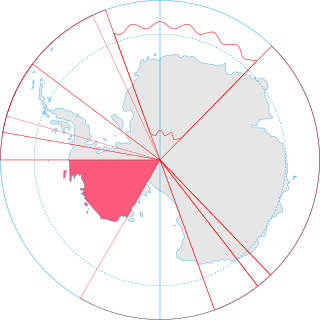Related Research Articles

Sovereignty can generally be defined as supreme authority. Sovereignty entails hierarchy within the state, as well as external autonomy for states. In any state, sovereignty is assigned to the person, body or institution that has the ultimate authority over other people in order to establish a law or change existing laws. In political theory, sovereignty is a substantive term designating supreme legitimate authority over some polity. In international law, sovereignty is the exercise of power by a state. De jure sovereignty refers to the legal right to do so; de facto sovereignty refers to the factual ability to do so. This can become an issue of special concern upon the failure of the usual expectation that de jure and de facto sovereignty exist at the place and time of concern, and reside within the same organization.
A territorial dispute or boundary dispute is a disagreement over the possession or control of land between two or more political entities.
The controversy surrounding the political status of Taiwan or the Taiwan issue is a result of World War II, the second phase of the Chinese Civil War (1945–1949), and the Cold War.

The Treaty of Peace between the United States of America and the Kingdom of Spain, commonly known as the Treaty of Paris of 1898, was signed by Spain and the United States on December 10, 1898, that ended the Spanish–American War. Under it, Spain relinquished all claim of sovereignty over and title to territories described there as the island of Porto Rico and other islands now under Spanish sovereignty in the West Indies, and the island of Guam in the Marianas or Ladrones, the archipelago known as the Philippine Islands, and comprehending the islands lying within the following line:, to the United States. The cession of the Philippines involved a compensation of $20 million from the United States to Spain.

Terra nullius is a Latin expression meaning "nobody's land". It was a principle sometimes used in international law to justify claims that territory may be acquired by a state's occupation of it. There are currently three territories sometimes claimed to be terra nullius: Bir Tawil, 4 pockets of land near the Danube due to the Croatia–Serbia border dispute, and parts of Antarctica, principally Marie Byrd Land.
In the United States, a territory is any extent of region under the sovereign jurisdiction of the federal government of the United States, including all waters. The United States asserts sovereign rights for exploring, exploiting, conserving, and managing its territory. This extent of territory is all the area belonging to, and under the dominion of, the United States federal government for administrative and other purposes. The United States total territory includes a subset of political divisions.
The right of conquest is a right of ownership to land after immediate possession via force of arms. It was recognized as a principle of international law that gradually deteriorated in significance until its proscription in the aftermath of World War II following the concept of crimes against peace introduced in the Nuremberg Principles. The interdiction of territorial conquests was confirmed and broadened by the UN Charter, which provides in article 2, paragraph 4, that "All Members shall refrain in their international relations from the threat or use of force against the territorial integrity or political independence of any state, or in any other manner inconsistent with the purposes of the United Nations." Although civil wars continued, wars between established states have been rare since 1945. Nations that have resorted to the use of force since the Charter came into effect have typically invoked self-defense or the right of collective defense.

Territories of the United States are sub-national administrative divisions overseen by the federal government of the United States. The various American territories differ from the U.S. states and Indian reservations as they are not sovereign entities. In contrast, each state has a sovereignty separate from that of the federal government and each federally recognized Native American tribe possesses limited tribal sovereignty as a "dependent sovereign nation." Territories are classified by incorporation and whether they have an "organized" government through an organic act passed by the Congress. American territories are under American sovereignty and, consequently, may be treated as part of the United States proper in some ways and not others. Unincorporated territories in particular are not considered to be integral parts of the United States, and the Constitution of the United States applies only partially in those territories.

Military occupation, also known as belligerent occupation or simply occupation, is the effective military control by a ruling power over a territory that is outside of that power's sovereign territory. The territory is then known as the occupied territory and the ruling power the occupant. Occupation is distinguished from annexation and colonialism by its intended temporary duration. While an occupant may set up a formal military government in the occupied territory to facilitate its administration, it is not a necessary precondition for occupation.

The state cessions are those areas of the United States that the separate states ceded to the federal government in the late 18th and early 19th centuries. The cession of these lands, which for the most part lay between the Appalachian Mountains and the Mississippi River, was key to establishing a harmonious union among the former British colonies.

Scarborough Shoal, also known as Bajo de Masinloc, Panatag Shoal, Huangyan Island, and Democracy Reef, are two rocks in an atoll administrated by China in the South China Sea. It is located between Macclesfield Bank, a sunken atoll of underwater reefs and shoals east of the Paracel islands and Luzon, the nearest landmass, 220 kilometres (119 nmi) away and the largest island of the Philippines.

The West Florida Controversy included two border disputes that involved Spain and the United States in relation to the region known as West Florida over a period of 37 years. The first dispute commenced immediately after Spain received the colonies of West and East Florida from the Kingdom of Great Britain following the American Revolutionary War. Initial disagreements were settled with Pinckney's Treaty of 1795.


The Island of Palmas Case was a territorial dispute over the Island of Palmas between the Netherlands and the United States which was heard by the Permanent Court of Arbitration. Palmas was declared to be a part of the Netherlands East Indies and is now part of Indonesia.
The Philippines has claimed many territories throughout its history. These territories include the Spratly Islands, portions of North Borneo, and the Scarborough Shoal.
The discovery doctrine, or doctrine of discovery, is a disputed interpretation of international law during the Age of Discovery, introduced into United States municipal law by the US Supreme Court Justice John Marshall in Johnson v. McIntosh (1823). In Marshall's formulation of the doctrine, discovery of territory previously unknown to Europeans gave the discovering nation title to that territory against all other European nations, and this title could be perfected by possession. A number of legal scholars have criticized Marshall's interpretation of the relevant international law. In recent decades, advocates for Indigenous rights have campaigned against the doctrine. In 2023, the Vatican formally repudiated the doctrine.


Annexation, in international law, is the forcible acquisition and assertion of legal title over one state's territory by another state, usually following military occupation of the territory. In current international law, it is generally held to be an illegal act. Annexation is a unilateral act where territory is seized and held by one state, as distinct from conquest and differs from cession, in which territory is given or sold through treaty.
The sovereignty of the Philippines refers to the status of the Philippines as an independent nation. This article covers sovereignty transitions relating to the Philippines, with particular emphasis on the passing of sovereignty from Spain to the United States in the Treaty of Paris (1898), signed on December 10, 1898 to end the Spanish–American War. US President William McKinley asserted the United States' sovereignty over the Philippines on December 21, 1898 through his Benevolent Assimilation Proclamation.

The Ligitan and Sipadan dispute [2002] ICJ 3 was a territorial dispute between Indonesia and Malaysia over two islands in the Celebes Sea, namely Ligitan and Sipadan. The dispute began in 1969 and was largely resolved by the International Court of Justice (ICJ) in 2002, which opined that both of the islands belonged to Malaysia.
References
- ↑ Klabbers, Jan. (2016). International law. New York. p. 76. ISBN 978-0-521-19487-7. OCLC 808810891.
{{cite book}}: CS1 maint: location missing publisher (link) - ↑ Nicholas, Barry. (1962). An introduction to Roman law. Oxford: Clarendon Press. p. 132. ISBN 0-19-876063-9. OCLC 877760.
- ↑ "Accretion - Oxford Reference".
- ↑ Kolla, Edward James (2017). Sovereignty, International Law, and the French Revolution. Cambridge University Press. pp. -1–2. ISBN 978-1-316-84606-3.
- ↑ "United States, Lyon et al. v. Huckabee". casetext.com. 1872.
- ↑ Gilbert, Jérémie (2006). Indigenous Peoples' Land Rights Under International Law: From Victims to Actors. BRILL. p. 32. ISBN 9781571053695.
- ↑ Benvenisti, Eyal (1 January 2004). The International Law of Occupation. Princeton University Press. ISBN 0691121303.
- ↑ "SEPARATE OPINION OF JUDGE AD HOC SREENIVASA RAO" (PDF). icj-cij.org. p. 156. Archived from the original (PDF) on 20 October 2017.
- ↑ "Arbitral Award on the Subject of the Difference Relative to the Sovereignty over Clipperton Island". The American Journal of International Law. 26 (2): 393. 1932. doi:10.2307/2189369. JSTOR 2189369. S2CID 246005364.
- ↑ "The Island of Palmas Case (or Miangas): Award" . Retrieved 6 August 2017.